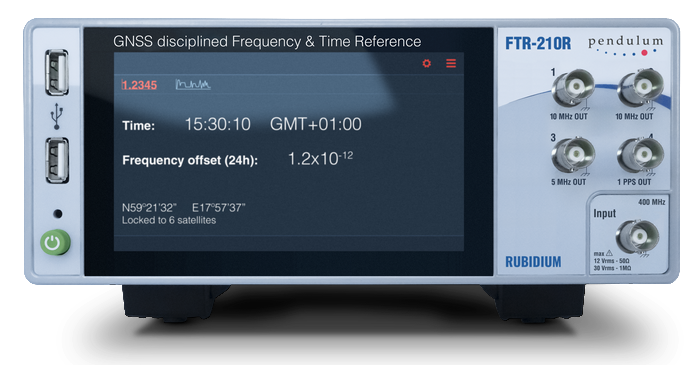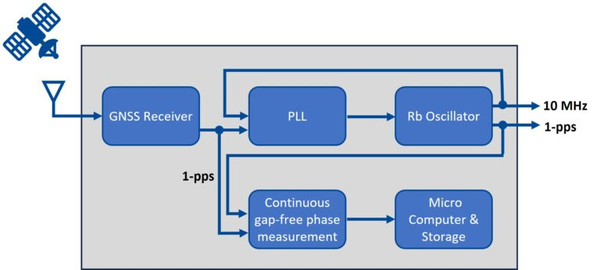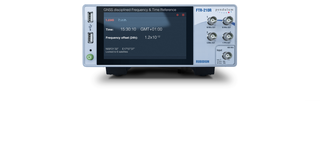Pendulum FTR-210R GNSS-disciplined Rubidium Frequency & Time Reference
The Pendulum FTR-210R GNSS disciplined Rubidium Frequency & Time Reference provides near Cesium-level stability through GNSS-based disciplining. There are 7 standard outputs (5×10 MHz, 1×5 MHz and 1×1 pps) that can be expanded with up to 4 extra outputs, plus a programmable 100 MHz pulse output option. The optional integrated independent frequency calibrator guarantees true traceability to the GPS time scale and NIST. Traceable calibration reports are easily generated. With Pendulum FTR-210R Rubidium Frequency and Time Reference, there is no need for yearly expensive calibration services from metrology labs. An optional input for frequency measurements to 400 MHz turns the FTR-210R into a one-box ultra-high performance frequency calibrator with up to 13-digit resolution in a second.

Frequency and/or Time Standard
When used as a GNSS disciplined Frequency standard, the short-term stability is very high, and ageing is virtually zero.
When used as a stand-alone Frequency standard, in manual hold-over mode, the stability is ultra-high. Ageing is less than 5х10-11/month.
When used as a GNSS disciplined Time standard, the 1 pps time reference output differs less than 10 ns rms from UTC. When GNSS disciplining is removed, the hold-over drift is very low; typical 1 µs/24 h.
Modular, multi-output configuration
The basic configuration contains 5×10 MHz, 1×5 MHz, and 1×1 pps outputs, to support other instruments, testers, or test objects. If that is not sufficient, 4 additional outputs can be fitted on the rear panel. These outputs are either:
- 4×10 MHz
- 4×1 pps
- 0.1, 1, 5, and 10 MHz
Additionally, you can enable an optional programmable pulse output, 0.5 Hz to 100 MHz, via a SW license, at any time.
Measurement input for one-box frequency calibration
The ultra-stable frequency reference, combined with the optional DC to 400 MHz measurement input, converts the FTR-210R Frequency and Time Reference to a complete one-box frequency calibrator. Measurement functions include Frequency, Period, Pulse width, Rise/Fall time, Slew Rate, and Voltage (Vmin, Vmax, Vp-p). TIE (Time Interval Error) is an optional function (SW enabled). The performance of the measurement input is state-of-the art. You have 14 ps time resolution (7 ps optional).
You can follow the short-term and long-term stability of the device under test on the 5” color display, both numerically and graphically. The measurement rate can be set from 1 MSa/s (20 MSa/s optional) up to one sample every 1000 s. You can store up to 32M of measurement samples in each session, and store up to 1G of measurements in a non-volatile memory.
The FTR-210R GNSS disciplined Rubidium Frequency and Time Reference can produce traceable calibration protocols in csv format of both the internal timebase reference (optional), and the device under test, at any time.
Unique Traceable Frequency and Time Reference for the calibration lab
The concept of traceability requires an unbroken chain of comparisons to international standards, on a continuing basis, where all comparisons produce documented results with stated uncertainty.
The option 220 in FTR-210R Frequency and Time Reference is a documenting frequency comparator/calibrator that is independent from the disciplining process. The received GNSS signal is gap-free and continuously measured against the local oscillator. Phase and frequency deviations are stored internally and can at any time be transferred to any PC.
A traceability record for print-out can be obtained. The unbroken calibration history chain – day by day – is maintained in the non-volatile memory for several years, with the current 24-hour mean offset being displayed continuously on the front panel color display.
New FTR-210R design – frequency comparator/calibrator feature works independently from the disciplining process:

Such unique traceability to primary standards means that the FTR-210R Frequency and Time Reference never needs to be sent away for traceable re-calibration. Thanks to this design, the very high stability built-in rubidium oscillator is continuously calibrated to the primary frequency standards in the US Naval Observatory, NIST, and ultimately to UTC.
Full flexibility for local or remote control
The FTR-210R disciplined Rubidium Frequency and Time Reference is operated manually on the bench via the 5” graphical touch-screen display. You can also connect a mouse, wired or wireless, to one of the front panel USB ports for easier operation.
The standard FTR-210R Frequency and Time Reference comes with two rear panel communication interfaces, Gbit Ethernet and USB 2.0*, for remote control and data transfer. Using a Wi-Fi dongle in the front panel USB port enables you to connect FTR-210R to your local wireless network. You can access and control the instrument from your lab bench, or from anywhere in the world using the integrated web server interface function.
Powerful and easy-to-use calibration tools
The optional measurement input converts the FTR-210R Frequency and Time Reference to a 1-box Frequency Calibrator. Using the MATH function, the Frequency of the device under test can be displayed either as absolute frequency, e.g. “10.000 000 01 MHz”, or as deviation from nominal frequency, e.g. “10 mHz”, or as relative deviation e.g. “1х10-9”. Setting limits for calibration tolerance, with clear pass / fail indicators, further eases the manual or semi-automatic calibration.
Datasheets:
-
 Pendulum FRR-210R technical specifications
size: 713.72 kB
Pendulum FRR-210R technical specifications
size: 713.72 kB
H TEST a.s.
Šafránkova 3
155 00 Praha 5
+420 235 365 207
+420 235 365 204
Newsletter
Product news, invitations for fairs, seminars and trainings. We send electronically max. 3 times/month.
© 2025 H TEST a.s.
Created by eBRÁNA s.r.o. | Powered by CMS WebArchitect | SEO a internetový marketing


























